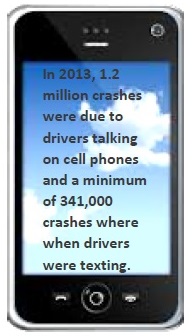Hands Free Is Still Distracted!
In this current fast-paced culture, cell phones have become an extension of our body and our main means to keep in communication with work and home. The increase of cell phone use over the last decade has been great for work productivity but has created very unsafe driving conditions.
How many times have you sat down in your work truck or personal vehicle and said to yourself, "I am not going to allow myself to be distracted." Then, minutes into the drive, you've changed radio stations multiple times, reached for your bag in the back seat, made a quick phone call, and then realized you're driving to the wrong destination. The non-distracted driver you had every intention of being just became the distracted driver that is more and more common on today's roadways.
Is Hands Free Safer?
 You may think because you are using a "hands-free" device you are being safer, but statistics show otherwise. According to the National Safety Council, drivers looking out the window while talking on a mobile phone miss up to 50 percent of what is going on around them. Multi-tasking is a myth. When talking on a mobile phone and even a hands-free device, the brain quickly toggles between two different tasks, leaving about two-thirds of the brain to process moving images such as vehicles, signage, pedestrians, and other objects coming in your line of sight while driving.
You may think because you are using a "hands-free" device you are being safer, but statistics show otherwise. According to the National Safety Council, drivers looking out the window while talking on a mobile phone miss up to 50 percent of what is going on around them. Multi-tasking is a myth. When talking on a mobile phone and even a hands-free device, the brain quickly toggles between two different tasks, leaving about two-thirds of the brain to process moving images such as vehicles, signage, pedestrians, and other objects coming in your line of sight while driving.
Extensive research shows the dangers of distracted driving. Studies say that drivers using phones are four times more likely to cause a crash than drivers not using a phone, and the likelihood that they will crash is equal to that of someone with a .08 percent blood alcohol level, the point at which drivers are generally considered intoxicated.
Traffic Fatalities
Distracted driving remains one of the top causes of traffic deaths and injuries in the United States.
- According to the Centers for Disease Control and Prevention, each day in the United States, more than eight people are killed and more than 1,161 people are injured in crashes that involve a distracted driver.
- The National Occupant Protection Use Survey1 states that each day across America, approximately 660,000 drivers are using cell phones or manipulating electronic devices while driving, a number that has held steady since 2010.
"We've spent billions on air bags, antilock brakes, better steering, safer cars and roads, but the number of fatalities has remained constant," said David Strayer, a psychology professor at the University of Utah and a leading researcher in the field of distracted driving. "Our return on investment for those billions is zero,” he added. “And that’s because we’re using devices in our cars."
Our Distracted Everyday Life
Today, people no longer get into their vehicle just "to drive." Vehicles have become an extension of everyday life with calls being made, emails and texts answered, and notes written, all while driving. Whether using a hand-held or hands-free device to complete these tasks, the end result is the same. Devices are a distraction from the main purpose of operating a motor vehicle.
"Driving a car is a very complex task," says Barbara Harsha, executive director of the Governors Highway Safety Association (GHSA), which estimates that distractions are associated with 15 percent to 25 percent of crashes at all levels. "It requires your complete attention. All it takes is a glance away for more than two seconds and you can get into serious trouble."
Legislation and Employer Responsibility
According to the GHSA, as of July 2016, 14 states have a full hand-held ban, 38 states have full cell phone bans on "novice drivers," and 46 states ban text messaging for all drivers. This is progress, but it is up to each individual to weigh the importance of using a cell phone or hands free device over their own and others' safety.
Employers are beginning to lead the charge to end distracted driving, taking on the responsibility of creating a safer work environment for their employees. Expectations on employees to use cell phones for business when driving exposes them to a preventable crash risk.
Action can be taken to reduce risk by creating and promoting a corporate cell phone policy banning the use of hand-held and hands-free mobile phones while driving. Changing the culture can go a long way toward demonstrating to employees that they truly are a company's greatest asset!
Michelle Boeldt is the Client Relations & EHS Marketing Manager for Fehr Graham, a premier provider of engineering, environmental, and funding solutions for commercial, industrial, institution, and government clients. Its mission is to improve the quality of life for its clients in the communities where they live and work by providing collaborative, insightful, results-driven solutions. Visit www.fehr-graham.com for information.
Posted on Jul 08, 2016